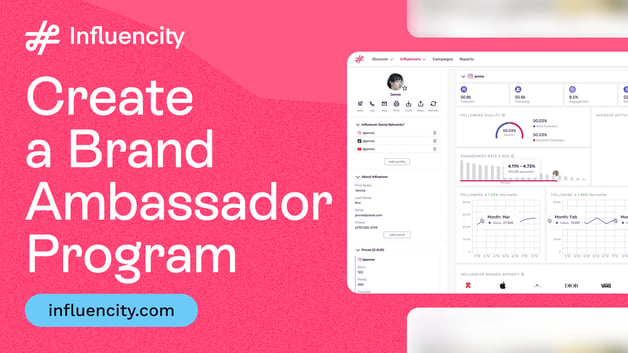Influencer Marketing Metrics You Should Be Measuring
When it comes to influencer marketing, there are a series of influencer marketing metrics that you need to track on a regular basis. These essential KPIs help you evaluate the effectiveness of your campaigns so that you can optimize your influencer marketing strategies.
In today’s post, we will detail all the influencer marketing metrics that you should be monitoring each time you launch an IM campaign. That way, you will be able to quantify your ROI and make data-driven decisions that enhance your current and future marketing efforts.
What Are Influencer Marketing Metrics?
Influencer marketing metrics are quantifiable measurements used to assess the performance and impact of an influencer marketing campaign and the overall success of collaborations between a brand and an influencer. They encompass factors like follower count, likes, comments, shares, click-through rates, and conversion rates.
Tracking these influencer marketing metrics is crucial as it helps brands assess the return on investment (ROI) of their influencer partnerships, determine the resonance of their message with the target audience, and refine future strategies for maximum reach and engagement, ensuring the efficient allocation of resources and successful campaign outcomes.
Influencer Marketing Metrics You Should Be Monitoring
Whether you are launching an e-commerce campaign or you want to measure the ROI of a TikTok influencer marketing campaign or one on any other platform, there are a number of key influencer marketing metrics that you should be tracking on a regular basis.
Monitoring the following key performance indicators will help you paint a comprehensive picture of your campaign's performance, allowing you to refine your approach, identify high-performing influencers, and allocate your resources optimally. That way, you can make data-driven decisions that enhance the impact of your campaigns, strengthen your brand-consumer relationships, and, ultimately, achieve your marketing objectives more effectively.
Likes, Comments, and Shares
Likes, comments, and shares are fundamental influencer marketing metrics that offer a glimpse into how much your target audience is interacting with your campaigns. For instance, the more likes your campaigns generate, the stronger the initial connection and affinity your content is building. Comments delve deeper, reflecting a higher level of engagement and conversation. Shares, in turn, extend your reach beyond your immediate follower base, potentially creating a ripple effect of exposure.
You can, of course, track all these interactions manually on each social media platform. However, this can be time-consuming and this approach is often prone to errors. A far better alternative is using influencer marketing analysis tools to streamline and automate the process.
For example, with Influencity Reports, you can manually configure tracking for all public YouTube, TikTok, and Instagram data (posts, videos, and carousels), including the number of likes and comments and the average number of interactions on combined posts. You can also automatically track all this data, provided the influencer you are monitoring has a public account and at least 1,000 followers. That way, you can be sure that the influencer you choose to work with has a proven track record and, once they have launched your campaign, that they are generating anticipated results.
Ultimately, by understanding and analyzing these interactions, you can tailor your messaging, adapt your strategies, and build relationships that go beyond superficial metrics, yielding more meaningful and lasting connections with your target audience.
Engagement Rate
Engagement rate is another crucial influencer marketing metric that provides a comprehensive overview of the degree of audience interaction. It calculates the percentage of followers who actively engage with content through likes, comments, and shares. However, this metric goes beyond basic follower counts, offering a deeper insight into the content's ability to captivate and resonate with the target audience. A higher engagement rate signifies a stronger connection and better content alignment, contributing to increased brand awareness, loyalty, and potential conversions.
To calculate your average engagement rate, simply divide a campaign’s total number of interactions by the number of followers then multiply by 100 to obtain a percentage.
Reach and Impressions
Monitoring a post’s reach and impressions helps you quantify the scope and visibility of your campaigns. You can identify how many unique individuals are exposed to your content, the size of your potential audience, and how often your content is displayed, including multiple views by the same user. This helps you understand how effective your content distribution strategy is and the degree to which your campaign is penetrating your target audience so that you can maximize the impact of your influencer collaborations.
You can use Influencity’s reporting features to monitor all this data. Plus, you can track an influencer's audience distribution data including top country, top city (Instagram only), top gender, and most popular age range. That way, you can be sure your influencer aligns with the unique characteristics and objectives of your campaigns.
Cost per Engagement
Cost per Engagement (CPE) is a vital influencer marketing metric that measures the financial investment required for each audience interaction with your content. It calculates the cost of likes, comments, and shares, providing insights into the impact of your investment in terms of generating active audience participation.
CPE can also be used to evaluate the effectiveness of specific influencer collaborations, content types, or platforms by measuring the tangible return on investment for engagement-driven goals. This data guides budget allocation and content strategy adjustments, enabling brands to optimize their resources for higher engagement rates, improved audience connection, and ultimately, more meaningful and profitable relationships with their target demographic.
To calculate your CPE, simply divide the total influencer cost by your total number of engagements.
Cost per Mille
Cost per Mille (CPM) measures the expense incurred for reaching a thousand potential viewers. It serves as a benchmark for evaluating the cost-efficiency of content distribution across diverse platforms.
CPM is especially valuable when comparing campaign costs against varying audience sizes, platforms, or content formats. By calculating CPM, brands can identify the most cost-effective channels for expanding their content's reach, optimizing their advertising budget, and ensuring their message resonates with a wider audience.
To calculate your CPM, simply divide the total influencer cost by your total impressions then multiply by 1,000.
Cost per Reach
Finally, Cost per Reach (CPR) measures the financial cost of reaching a single unique user within your target audience. This metric delves beyond mere impressions, accounting for the actual potential touchpoints with individual consumers.
Calculating Cost per Reach allows brands to identify how cost-effective their campaigns are in terms of connecting with specific individuals, ensuring the efficient allocation of resources. As a result, brands can fine-tune their influencer partnerships, content strategies, and platform selection, optimizing their efforts to achieve heightened engagement and maximized results within their desired audience segments.
To calculate this influencer marketing metric, simply divide the total influencer cost by your total reach.
Tags:






















%20and%20How%20Can%20They%20Benefit%20Your%20Brand%20article.jpg?length=628&name=What%20Are%20Key%20Opinion%20Leaders%20(KOL)%20and%20How%20Can%20They%20Benefit%20Your%20Brand%20article.jpg)








